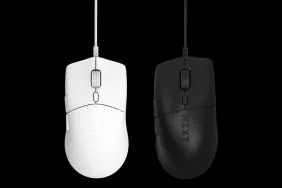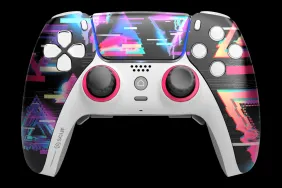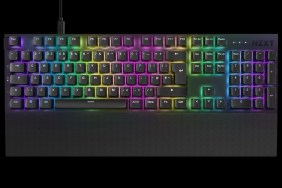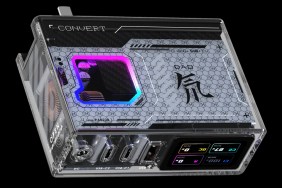The dogs of war.
Yep, there’s your problem right there. Your overhead camshaft, a Tarakian XM-2032, ain’t got but a few more miles in it, and it sure don’t benefit from being welded to a Morskoj 404 generator assembly. You’re gonna need to junk at least half of this thing, replace the ball bearings in the rotary drive, and upgrade your electronic doo-hickeys. I can do it for ya, but it’s gonna cost at least a million Sal Kar dollars and don’t expect it to be out of the shop until Sunday. You can see yourself that I’m all backed up here.
Oh, you want to go into the business of mech construction and maintenance for yourself? Well, kid, here’s a tip: go out and get Chromehounds, Sega’s mech maintenance simulator. Get familiar with the parts and don’t undercharge for labor. It ain’t going to be quick, but the game will get you up to speed.
And that speed is five miles per hour.
[image1]Calling a mech game slow is like criticizing a model for being hungry, but Chromehounds seeps pacing problems out of every loose nut. Between the plodding Hounds (mechs), the endless customization, the creeping single-player game and the incessant waiting in lobbies for online play, it’s not for the ADD afflicted. But if you can customize tank decals and weaponry alignment until your room reeks of unwashed sweat and grease, then this, my budding Lockheed Martin engineer, is the game for you.
The premise has three superpowers battling over a region of the world surprisingly shaped like the Middle East. Americans back the democratic state of Tarakia, Russians back the Morskoj, and some unnamed Asian country (or possibly Middle-Eastern) backs the Sal Kar. It’s unclear how the mix of real and fake countries makes the game any more compelling, and lord knows why the developers put up a disclaimer on the opening screen asserting that the “events in this game are fictional” and “not based on real events.” Um, you drive thousand-ton tanks that walk on legs. Wait, is this the secret robot war that my history teachers neglected to tell me about? I think it happened sometime between the Haymarket riots and the Monroe Doctrine. AHA!
This not-so-historical conflict is fought by giant, vaguely anthropomorphic tanks called Hounds. The single-player campaign is divided into scenarios introducing you to the various types; as you progress through each story, you learn the various tactical differences between, say, a Scout Hound on wheels (great for recon) and a Heavy Gunner Hound on crab legs (great for killing). As a tutorial, the missions perform adequately, but the storytelling is as dry and stale as Morskoj’s communist toast.
Perhaps this is because the story is told entirely through disembodied dialogue – or rather, monologue. I get that the woman telling me her sad story about being raised on Morskoj toast is supposed to be inside the tank in front of me, but tanks don’t have lips (yet). Imagine looking at an immobile tank while listening to a five-minute speech about some political strife that is obviously not based on real events. It’s like the History Channel, except fake and more boring.
Ultimately, the paltry single-player campaign is a giant smoking wreck out of which you can only salvage a few choice parts, literally. After each mission, you receive a part as a reward. In time, those little gears and guns become the only reason to play the single-player game, as it is just no fun at all.
But while you won’t care at all about the war, you will care about your Hound. Before too long, you’ll ditch the pre-set junkers the game gives you and begin building your own from the ground up. You will spend at least one-third of your time in the garage, fitting and refitting your Hound with guns, ammunition, computer chips, generators, heat sinks, armor, night vision, etc. The game comes from From Software, the guys behind the Armored Core series, after all. The kitchen sink, I imagine, will be available for download soon.
[image2]Since the campaign sucks, most of the action in Chromehounds is found online. After joining one of the three warring countries, you’ll immediately wait while your other squad members fiddle with their Hounds or feed their cats. Getting a squad together and ready is like herding rabbits, as the lure of tweaking one more armor plate or reconfiguring a rifle draws players back into their garages. Thankfully, you can jump into the garage and tweak your machine while still maintaining voice contact with the other members of your squad.
Once everyone’s ready, you can battle squads from other countries, but that means another wait in another lobby as they get their squads together. Did I mention that the game was slow?
But the battles are over quickly. For all the time you’ve spent agonizing over the placement of your secondary generator, staring at lobby screens, and piloting your Hound across the expansive map to flank the enemy, you can die in a heartbeat. Get hit with a few enemy missiles in the space of a few seconds and your Hound is dead. It may put a premium on strategy and planning, but it also means inevitable frustration as you wait the rest of the game back at your base, Houndless and whining.
And with the exception of long-range bombardments, the battles are usually just circling and firing as fast as possible. The bigger the Hound, the slower it moves and turns, but the bigger Hounds usually carry more weapons, making them more lethal. There’s a kind of breathlessness while you wait to see who will blow up first, but it really isn’t action in the fast-paced, acrobatic sense.
Not all is lost, however, thanks to the inclusion of various role types. Commanders, for instance, can see enemy units on their maps, while quick Scouts are useful for taking control of radar towers that expand the Commander’s range of view and your squad’s communication perimeter. Communication is very essential in the game, making it doubly essential that you find a squad without the annoying screaming kid who just learned the word “gay.”
Most of the other sounds are far less annoying. The background music is okay and the sound effects are crisp and atmospheric. You can hear the thudding booms and machine gun chatter from the next valley and watch tracer fire streak across the sky, even while your hound lumbers slowly to join in the fight.
I’ve managed to make it this far without saying much about the game’s look or control, mainly because the game is more about designing, strategizing, and waiting than it is about precise control or special effects. But even so, the game looks good: the hounds are well animated and the environments are nicely textured and feature big, gorgeous skylines. The picture-in-picture display is particularly elegant, allowing you to see both first-person and third-person views at the same time and toggle them with a button press.
[image3]However, the maps are too sparse and indistinct. The sandy desert area looks a lot like the grassy flatland area, which is just a green version of the arctic snowy area. There are few trees or buildings to liven up the look.
The control is solid and intuitive, allowing you to move, target and fire without having to think too much about it. But there are also some noticeable gaps; for instance, you can cycle your weapons with your right bumper in one direction, but you can’t cycle your weapons in the other direction. I don’t have to explain how annoying that can be to seasoned shooters.
Even more annoying is the inability to quit a game or leave a match in progress. No quitting? It’s a shallow oversight in what is otherwise a deep and complex game. [CORRECTION: Since the initial publish of this review, it has been brought to the writer’s attention that there is a way to quit during the middle of a game, but the process is unwieldly and obtuse. As no one will be able to figure it out without researching the small print of the manual or bribing me with several Tarakian dollars, I feel partially justified in my initial, albeit unfounded, astonishment.]
To its credit, the game does deliver some groovy little features, such as the ability to design and place decals on your hound, the ability to check out your other squad member’s hounds while waiting in the lobbies, and unique shops for each of the three warring countries. You can even bid for experimental or captured enemy parts, which are distributed via a lottery system. Nothing says “winner” like a virtual tank tread.
And nothing says “uneven” like Chromehounds. It stumbles in its lame single-player and brutally slow pacing, but offers a nice amount of customization for would-be mech mechanics, leading to a game perfect for the chop shop and lousy for the road.
-
Tons of customization options
-
Interesting multi-player roles
-
Anemic single-player
-
Sparse maps and modes
-
Lots of waiting











